Carambola, also known as Star fruit, is a small to medium-sized tree that produces juicy tropical fruit. The flavor mixes Apples, Grapes, and Citrus and is crispy in texture. The fruit can be eaten fresh and is often used as a garnish in salads because of its unique star shape. Star fruit trees are attractive, with curved branches and a large mass of lilac purple flowers that attract pollinators. Star fruit is 3 to 4 inches long with waxy skin and five prominent ridges. A cross-section of the harvested fruit looks like a 5-pointed star.
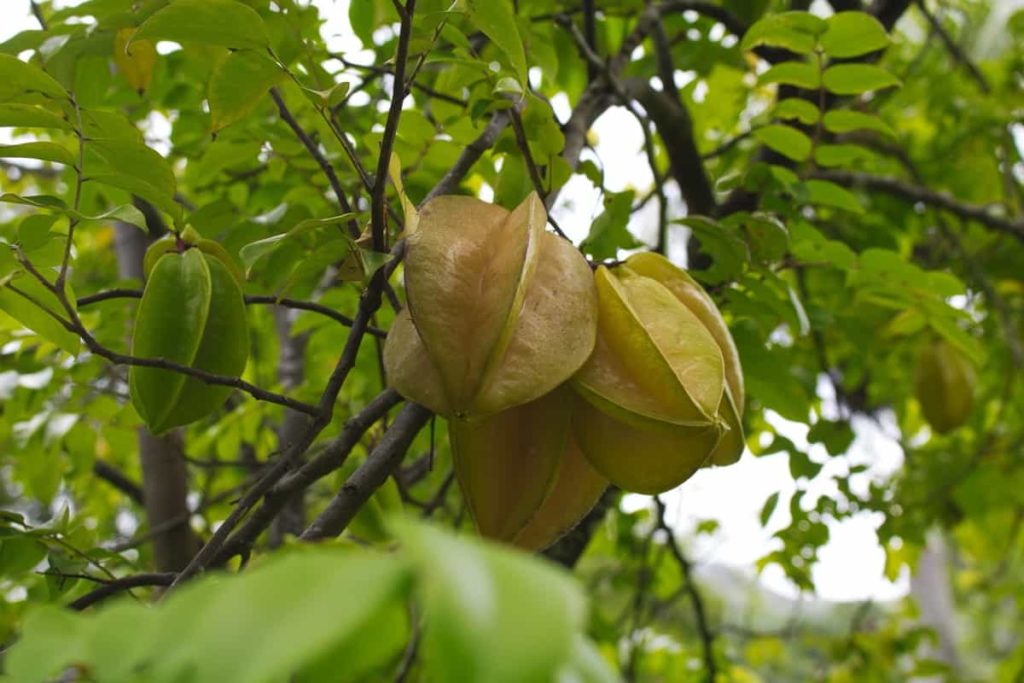
How to grow Star Fruit/Carambola from seed to harvest
How long does it take to grow Star fruit from seed?
- The Star fruit tree is 40 years old and reaches a height of 22 to 33 feet, spreading 20 to 25 feet in diameter. Star fruit seeds quickly lose their ability. When they are plump and mature, they should be cut with fruit, then planted in a few days.
- Seed-grown Star fruit trees produce fruits in three to eight years, while grafted varieties only take one to two years. Depending on the variety, cultural practices, and season, it takes about 60 to 75 days for fruit to mature.
- After taking care of it during its first year, you can expect fruit in either year 2 or 3. Home-grown Star fruit trees protected from strong winds can often be harvested within 10 to 14 months of planting, provided they are two years older.
Can you grow Carambola from seed?
- Star fruit can be grown from grafted saplings or fresh seeds. The former works fast, producing edible fruits quite quickly, while propagation from seed takes many years from planting to the first harvest. If you decide to grow Star fruit from seeds, you. Therefore if need to work carefully.
- Star fruit trees can be challenging to find in a shop, but they can be grown with fresh seeds from ripe fruit. However, Star fruit trees grown from seeds take longer to bear fruit than grafted trees, and their fruit may not be the same quality.
- Star fruit sprouts easily from fresh seeds. However, after being removed from the fruit, the ability decreases very quickly.
How do you germinate Star fruit seeds?
- Wash the Star fruit seeds and soak them in water for 24 hours and then put them on a damp paper towel, cover with another damp paper towel, and put the towel sandwich in a ziplock bag. You should close the bag and place it in a warm place. The seeds are growing slowly and should sprout within two weeks.
- Seed germination varies from one week in summer to two or more weeks in winter. You can start fresh Star fruit seeds in moist peat moss. Once sprouted, you can transplant the seedlings into pots that contain sandy loam soil.
- It takes seven to 20 days for the seeds of the Star fruits to grow, depending on the weather and their growing condition. For example, summer produces growing conditions in winter or stakes longer in unusually cool summer.
In case you missed it: Star Fruit Gardening for Beginners – Tips, Techniques
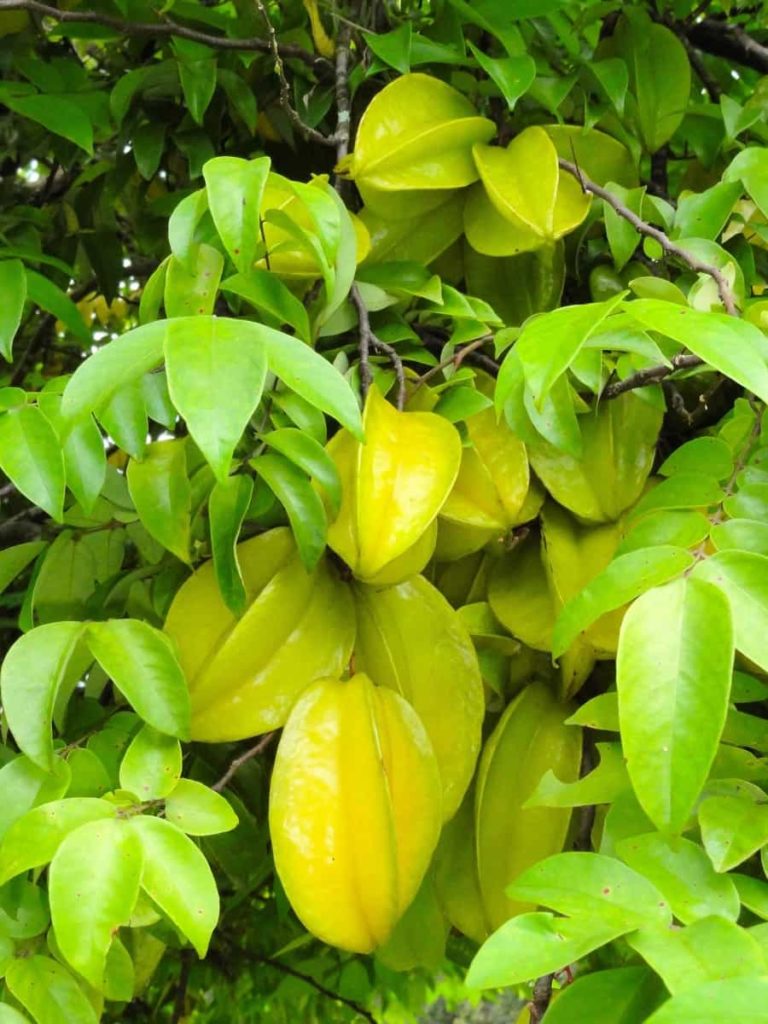
Does Star fruit tree need full sun?
- Star fruit will tolerate full sun but prefers partial shade. The tree will try to bear fruit in the first year. Pull out any fruit that forms in the first year to trigger the growth of the roots.
- You should plant Star fruit trees in full sunlight, and regular irrigation should be provided throughout the year. However, be careful because Star fruit trees are sensitive to overwatering. If fertility in your soil is low, fertilize the trees with a light application every 60 to 90 days until they are established.
- The best place to grow Star fruits is under completely sunny conditions. Moreover, the environment is hot and humid, and it is essential to keep it free of frost.
- Plant the Star fruit in full sunshine, away from other trees, buildings, structures, and power lines. The plant needs well-drained soil, better fertilization, air protection, and warmer temperatures. It may also require supplementary irrigation as Star fruit is not drought-tolerant.
Do Star fruit trees lose their leaves?
- Star fruit trees are evergreen, although they lose some or all of their leaves in late winter and early spring when grown in cool places.
- Star fruit trees are subtropical and can reach heights of about 25 to 30 feet and 20 to 25 feet across under ideal conditions. The tree is evergreen in warm climates, but its leaves will be lost when the temperature drops below -3°C.
How do you know when to pick Star fruit?
- A ripe Star fruit will be strong to touch, have a bright yellow color, and may have slightly brown edges. Occasionally patches of green are fine, but if a Star fruit is primarily green in color, it is not ripe. You can also buy Star fruit when it’s green and wait for it to ripen; leave it on your counter for a few days.
- Star fruit is harvested by hand from a tree or shaken down by a machine. They are harvested when the fruit turns yellowish-green. Morning harvesting is preferred when the temperature is cool. Ripen Star fruit should be essentially yellow with only hints of green.
How much water does a Star fruit tree need?
- The Star fruit plants require constant water, and the soil should be moist. Need deep water, once or twice a week. Reduce the plant’s water during winter, as it does not require a lot of water. In terms of health, the Star fruit plant can withstand water flooding for two to ten days.
- Use slow-release granular fertilizer with balanced liquid fertilizer 4 to 5 times a year or several times during the growing season. Star fruit performs well with regular water. There is no need for extra water during the rainy season.
What kind of soil does Star fruit need?
- The Star fruit embraces a variety of soil textures. Loamy soil is ideal for planting with adequate amounts of organic matter. For maximum growth, the pH level should be between acidic and neutral. The Star fruit tree has an excellent performance in loamy soil with good drainage.
- As long as the soil removes surplus moisture, it’s fine for your plant. Loamy soil that contains a good amount of organic matter is suitable for planting. The pH level should range from neutral to acidic for maximum growth. Try to adjust the pH level between 4.5 and 7.
Can you grow Star fruit indoors?
- It’s an easy-to-grow indoor fruit tree that produces flowers and fruits when it’s only 1 1/2 to 2 feet tall. The Star fruit blooms periodically throughout the year with small clusters of lilac-colored flowers.
- Indoor fruit will be as sweet as the fruit growing outdoors on large trees. Grow Star fruit trees in full sunshine in any good, well-drained potting soil. They perform best with indoor temperatures above 13°C. Occasionally feed with an internal organic fertilizer when the plant is actively growing.
In case you missed it: Star Fruit Growing Tips, Hints, Techniques, Secrets
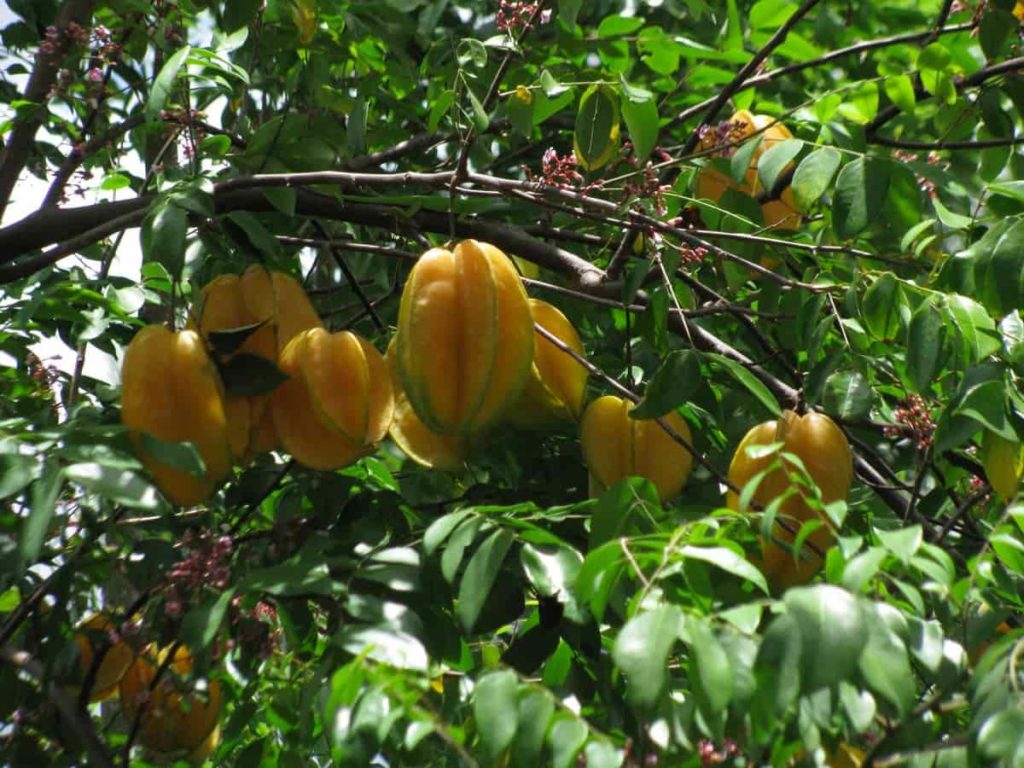
How often do Star fruit trees produce fruit?
- Star fruit trees grown in wind-protected areas can start bearing fruit within 10 to 14 months of planting. Generally, 4.5 to 18 kg of fruits per tree can be expected annually during the first two to three years.
- Star fruit will usually produce around 300 fruits per tree at the age of 2 years. The production will increase from year to year and nine years and above where the production will be stabilized.
- As trees reach full maturity at the age of 7 to 12, each tree can produce up to 136 kg of Star fruit annually.
Do Star fruit continue to ripen after picking?
- You can also buy Star fruit when it’s green and wait to ripen; leave it on your counter for a few days. When overripe, the Star fruit turns entirely yellow, and brown spots appear everywhere.
- Leave the fruit on the counter for one to two days to fully ripen until the skin turns yellow and the rib tips turn brown. Turn the fruit every 12 hours while ripening. Prepare this ripe fruit for a sweet taste with a grape-like texture.
What season does Star fruit grow?
- The Carambola or Star fruit growing season is usually between June to September and November to February. Star fruits are up-to-date at these times, but you can still get extra Star fruits throughout the year. However, in the season, fruits usually taste better because they are fresh.
- Climate and weather play a role in determining when and how often Star fruit trees produce fruit. In areas with a definitive blooming season, the harvest time of Star fruit is usually in late summer or early autumn. Farmers usually expect the highest yield when harvesting Star fruit at this time of year.
In case you missed it: Star Fruit Seed Germination, Time, Temperature, Process
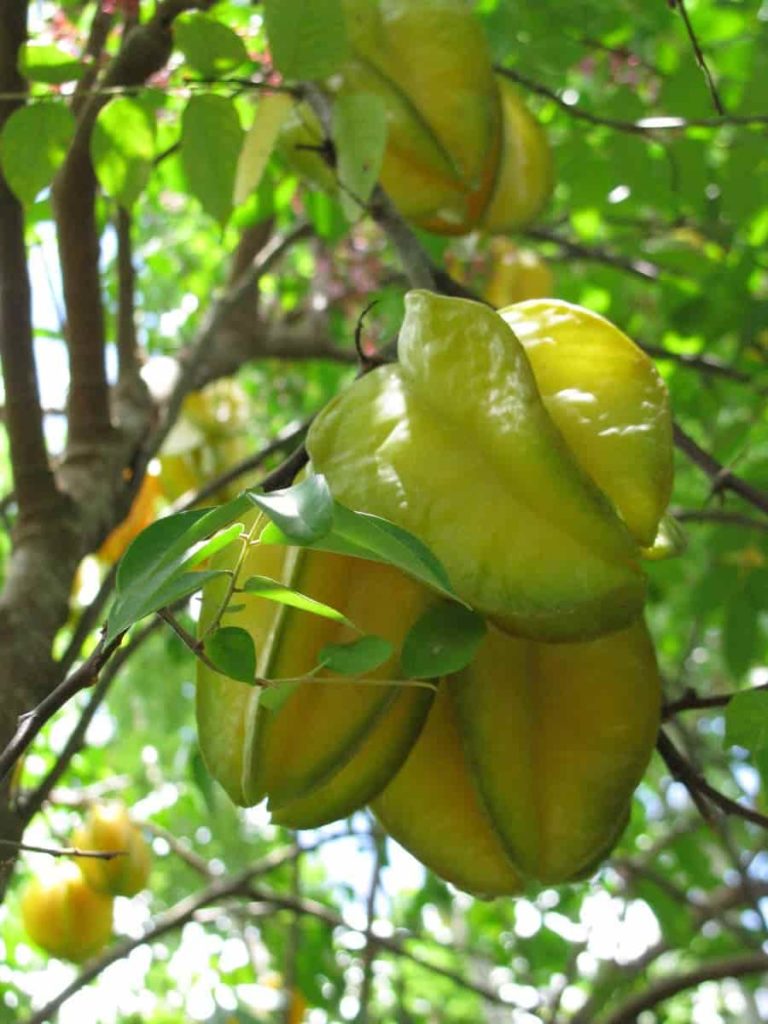
Can I grow a Star fruit tree from a cutting?
- For cutting, get an existing Star fruit tree, and cut branches with buds. You must cut the branch at an angle, put them into a rooting hormone, and then into a well-prepared polythene pack with potting soil. Water the cuttings and roots will be established soon.
Is Star fruit self-pollinating?
- Star fruit trees are self-fertile. Therefore, you will get fruit with just one plant. However, adding a Star fruit tree will significantly increase the size of your crop.
- The Star fruit trees are dioecious, i.e., a male and female Star fruit tree is needed to create a new tree. The Averrhoa Star fruit is not pollinated by the air but by insects.
How do you fertilize Star fruit?
- Fertilizer requirements for a fully grown tree vary from 4 to 6 times annually, and fertilizer use is required every 30 to 60 days for young plants. Try using 6-2-6 or 6-4-6 hybrid fertilizer, and it should also contain manganese, magnesium, zinc, and iron.
- Fertilize young Star fruit trees with ½-pound mixed fertilizer with a 6-6-6-3 until established, every 60 to 90 days. Mature trees need to be fertilized three times a year if planted in shallow soil, but only twice a year with deep soil. Use 1kg of fertilizer per year for every inch of trunk diameter.
- You can apply a layer of wood chips or bark mulch to help maintain soil temperature and humidity and reduce weeds’ growth. You should spread a 2 to 6-inch layer of mulch around the tree, leaving the mulch material about 12 inches away from the tree trunk.
In case you missed it: How to Start a Terrace Garden from Scratch in Pune/Maharashtra: For Vegetables, Fruits, Flowers, and Herbs
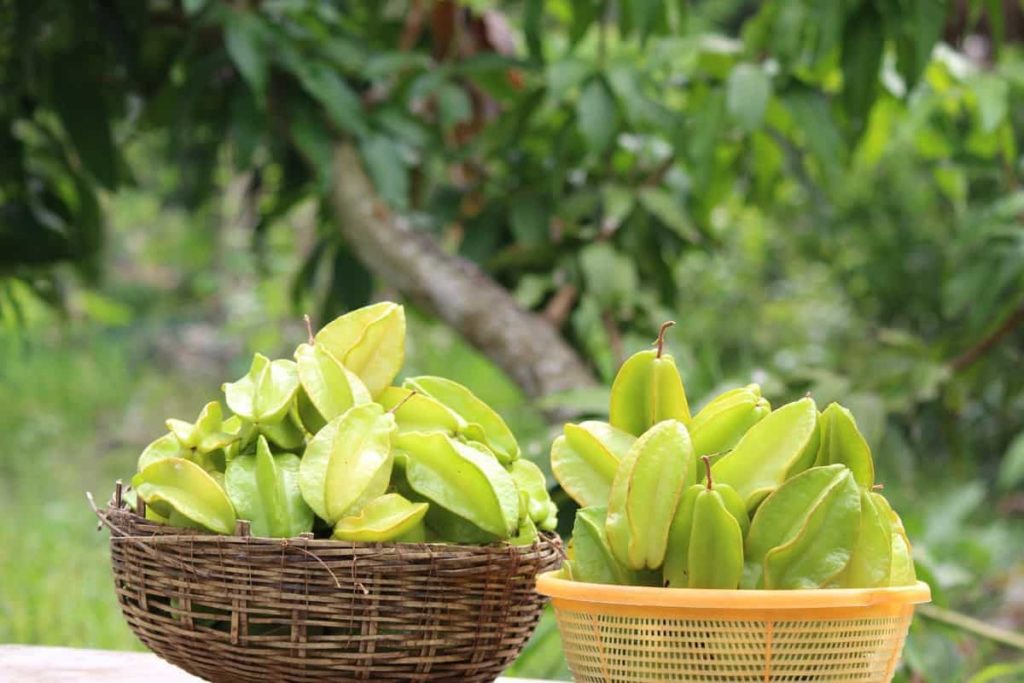
How many times can you harvest Star fruit?
- The harvesting time of the Star fruit may vary throughout the year. In some places, trees can produce two or three crops per year. Production in other areas may continue throughout the year.
- Climate and weather play a role in determining when and how often Star fruit trees produce fruit. In areas with a definite blooming season, the harvest time of Star fruit is usually in late summer or early autumn.
- Farmers usually expect the highest yield when harvesting Star fruit at this time of year. This is true in South Florida, where the prime time for selecting Star fruits is in August, September, and then from December to February.
How do you prune a Star fruit?
- Star fruit plants have a habit of growing upwards. Therefore, trees usually planted in the ground are rigorously pruned every year or two to maintain a manageable height of fruit. You should prune back out-reaching branches for dwarf Star fruit varieties grown in containers.
- Do your pruning at the end of winter before spring growth starts. This pruning does not disturb the fruiting cycle as soon as the flowers are formed on both young and large wood.
Where can you grow Star fruit?
- Commercial production now occurs in Hawaii, Florida, and other tropical regions. The best place to grow Star fruit is under completely sunny conditions. Moreover, the environment is hot and humid, and it is important to keep it free of frost. Anything below 2°C would be riskier, and less than -3°C would lead to death.
- The Star fruit tree is tropical and cannot survive in a region where temperatures drop below freezing. However, if it is moved to a greenhouse or sunny room inside the house for the winter, it can be grown in containers in cold areas.
In case you missed it: Homemade Fertilizers for Root Vegetables: Potatoes, Carrots, Beetroot, Onions, Radishes, Turnip, Ginger, and Garlic

Conclusion
Star fruit trees can be difficult to find in a garden shop, but they can be grown with fresh seeds from ripe fruit. Star fruit trees grown from seeds take longer to bear fruit than grafted trees, and their fruit may not be the same quality. Yet, the decorative value of their pink flowers and evergreen leaves enables them to grow. Once established, these trees are less caring and easier to grow, assuming you provide them with proper care.
- Best Liquid Fertilizer for Flowering Plants
- How to Set Up an Efficient Watering System for Home Garden
- How to Mulch Tulip Bulbs: Expert Tips Best Tulip Blooms
- Common Problems with Potted Figs and How to Solve Them
- How to Prevent Flower Drops in Pomegranate Trees: Effective Tips
- How to Boost Ridge Gourd Flowering and Yield: A Beginner’s Guide
- Effective Pollination Techniques for Maximizing Gourds Yield
- Composting Techniques for Manure in Home Gardens
- A Step-by-Step Guide on Propagation Techniques for Jasmine Plants
- How Do I Make My Garden Less Cluttered: A Beginners Guide
- Growing Red Currants at Home for Beginners
- Gardening Techniques in Planting Vegetables
- Where to Place Indoor Plants in Your Home
- How to Grow Tomatoes Organically at Home: A Comprehensive Guide
- Organic Gardening on a Budget: Low-Cost Methods and Materials
- Gongura Seed Germination and Planting Methods
- Cabbage Seed Germination and Selection
- Broccoli Seed Germination and Selection
- Asparagus Seed Germination and Variety Selection
- Seasonal Flower Gardening: Best Practices for Spring, Summer, Fall, and Winter
- How to Grow Hibiscus from Flower
- Plantation Ideas for Home Decoration: A Beginners Guide
- Flower Garden Designs and Layouts for Beginners
- Planting and Spacing Techniques in Papaya: A Beginner’s Guide
- Growing Gold: Essential Techniques for Planting Pineapples
- How to Make Kalanchoe Plant Bushy: Home Remedies and Solutions
- 11 Reasons Why Your Gardenia is Not Blooming: Home Remedies and Solutions
- Eco Elegance: The Guide to Designing a Drought-Tolerant Landscape
- Gardening on a Slope: Strategies for Hillside Landscaping
- Nourish and Flourish: Top Organic Mulches for Thriving House Plants
- Everything You Want to Know about Indian Mogra Flower: Discover Uses and Growing
- Green Thumb Success: Expert Tips for Cultivating Greenhouse Pumpkins All Year Round
- Maximize Growth & Flavor: The Ultimate Guide to Companion Planting in Herb Gardens
- How to Control Rhododendron Problems Naturally: Home Remedies and Organic Ways to Fix Them
- Natural Magic: The Remarkable Benefits of Cinnamon for Plants
- Best Steps to Revive Dying Tulip with Natural and Organic Treatment